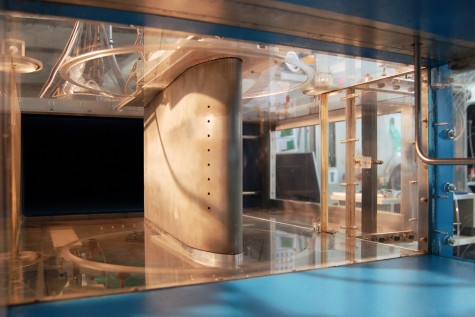Cyclone cooling:
The current research project at this test rig is being carried out under the framework of Lufo 4 in cooperation with Rolls-Royce Germany.
By increasing the turbine inlet temperature and with it the linked working capacity of the hot fluid, increased performance can be gained with an adapted turbine of a jet engine.
For that purpose, it must be guaranteed that all the separate stages of the turbine have sufficient stability and durability, even at high inlet temperatures. The inlet temperatures of today’s jet engines already lie beyond the melting temperature of the blade material. Over the past years the possible temperature could be raised continuously by materials research and coatings. However, an additional cooling of the blades with air diverted from the compressor must be conducted. For the time being, only an effective internal cooling in combination with film cooling is considered for the first turbine stage. Thereby the cooling film lays itself like a protective film over the blade surface and serves as an additional isolation layer against the hot air.
On the one hand, the increased pressure conditions in the jet engine constantly warm the cooling air which is diverted from the compressor. On the other hand, as much air as possible should go into the combustion chamber for the burning process. Therefore the enhancement of the cooling effectivity is one of the most important goals of an engineer, who is constructing blade cooling systems.
A promising method for the convective internal blade cooling is the so-called cyclone cooling, with which the internal heat transfer between blade and cooling air can be increased considerably, compared to the conventional convective internal cooling methods. Using this cooling method, a twist is forced onto the cooling air when entering the blade cooling channel. A strong secondary flow component is developed which superposes the radial flow component.
At the cyclone film cooling wind tunnel, the influence of the cyclone cooling on the cooling film is being explored.


